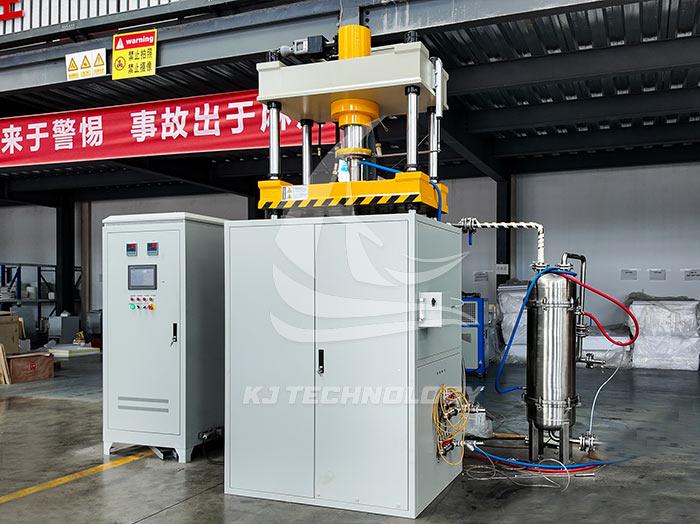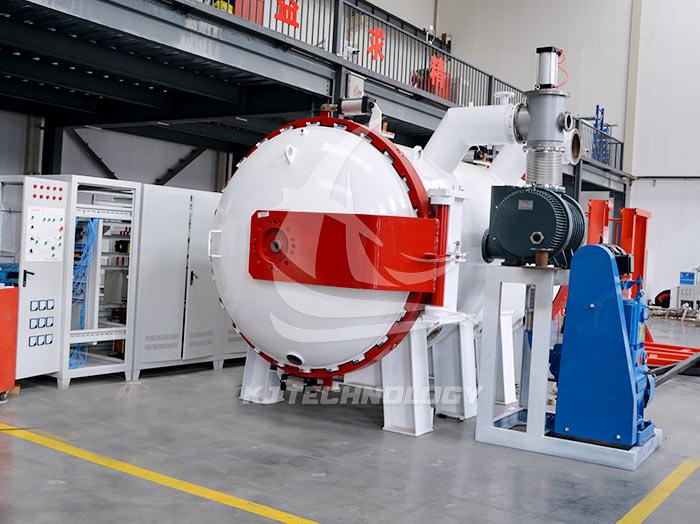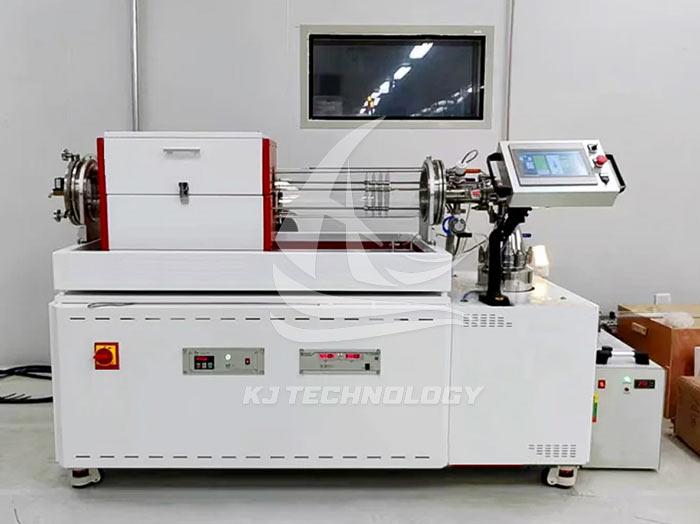Common faults and solutions of graphite vacuum furnaces used in laboratories
 07-22-2025 Author: KJ technology
07-22-2025 Author: KJ technology
The common faults and solutions of graphite vacuum furnaces used in laboratories can be summarized into the following four categories:
1. Vacuum system malfunction
a. Insufficient vacuum degree or decreased pumping efficiency
Possible reasons:
Vacuum pump malfunction (such as pump oil contamination, aging parts, insufficient oil level).
Seal failure (aging or deformation of sealing rings at furnace doors and pipeline interfaces).
Leakage points (cracking of furnace body welds, damage to thermocouple inlet seal).
Valve or pipeline blockage (failure of pneumatic valve operation, residual debris in the pipeline).
resolvent:
Check the vacuum pump: observe the color of the pump oil (if it turns black or cloudy, it needs to be replaced), measure the pump port pressure (if it is lower than the standard value, the pump needs to be disassembled for maintenance).
Test sealing: Apply soapy water or use a helium mass spectrometer leak detector to check the connections of furnace doors, flanges, etc., and replace aging sealing rings.
Cleaning pipelines: Remove filters and valves, remove foreign objects, and check the working status of solenoid valves.
Repair leakage point: Repair the welding seam of the furnace body and re apply AB glue to seal the thermocouple inlet.
b. Vacuum gauge error
Possible reasons: Sensor malfunction or calibration deviation.
Solution: Compare the standard pressure gauge and recalibrate or replace the faulty sensor.
2. Temperature control malfunction
a. High temperature alarm
Possible reasons:
The temperature controller parameters are incorrect.
Solid state relay breakdown.
Poor contact of thermocouple probe.
resolvent:
Calibrate the temperature controller parameters and refer to other normal equipment settings.
After a power outage, use a multimeter to measure the resistance at the output terminal of the solid-state relay (normally, it should be ≥ a few megohms, and if it approaches 0, it needs to be replaced).
After powering on, gently shake the thermocouple probe and observe whether the temperature controller displays any jumping (if the jumping amplitude is large, the probe needs to be replaced).
b. The displayed temperature is too low or cannot reach the set value
Possible reasons:
The thermostat has no output signal.
Thermocouple damage or polarity error.
The heating tube is not powered or damaged.
Power supply issues (unstable voltage, oxidized contactor contacts).
resolvent:
Check the parameters and output signals of the thermostat, and calibrate the PID regulation function.
Replace the spare thermocouple for testing and check the polarity of the compensation wire.
Use a test pen to test the wire connecting the heating tube, and use a clamp gauge to measure the current difference (if the difference is large, the heating tube needs to be replaced).
Test the balance of three-phase voltage, clean the contactor contacts or replace damaged components.
3. Mechanical structural failure
a. Poor closure of furnace door
Possible reasons: hinge deformation, lock failure, or furnace body deformation.
Solution: Correct the hinge position, replace the deformed lock buckle, and repair the deformed part of the furnace body.
b. Abnormal noise from the fan
Possible reasons: lack of oil in fan bearings, loose motor screws, or foreign object intrusion.
Solution: Disassemble the fan to clean foreign objects, replenish lubricating oil, and tighten the motor fixing bolts.
c. Pneumatic valve cannot operate
Possible reasons: Electromagnetic valve malfunction or insufficient compressed air pressure.
Solution: Check the working status of the solenoid valve to ensure that the compressed air pressure is within the range of 0.4-0.6MPa, and replace the pneumatic valve if necessary.
4. Malfunctions related to materials and processes
a. Oxidation or discoloration of graphite components
Possible reasons:
Excessive temperature leads to graphite oxidation.
Gas leakage (spare parts in blue).
High moisture content (parts are green in color).
resolvent:
Check the temperature controller settings to ensure that the cooling system is operating normally (with normal water flow and temperature).
Repair the gas leakage point and adjust the vacuum degree to reduce the oxygen content.
Extend the exhaust time to ensure dryness inside the furnace.
b. Carbon addition in parts processing
Possible reasons: Low cleanliness of the heating chamber or residual heat from the feeding cart.
Solution: Clean up the residue in the heating chamber and ensure that the feeding cart cools down before entering the heating chamber.
c. Failure of heat shield
Possible cause: Partial damage to the carbon fiber insulation screen.
Solution: Replace the damaged insulation screen, check the connection and resistance value of the heating element.








